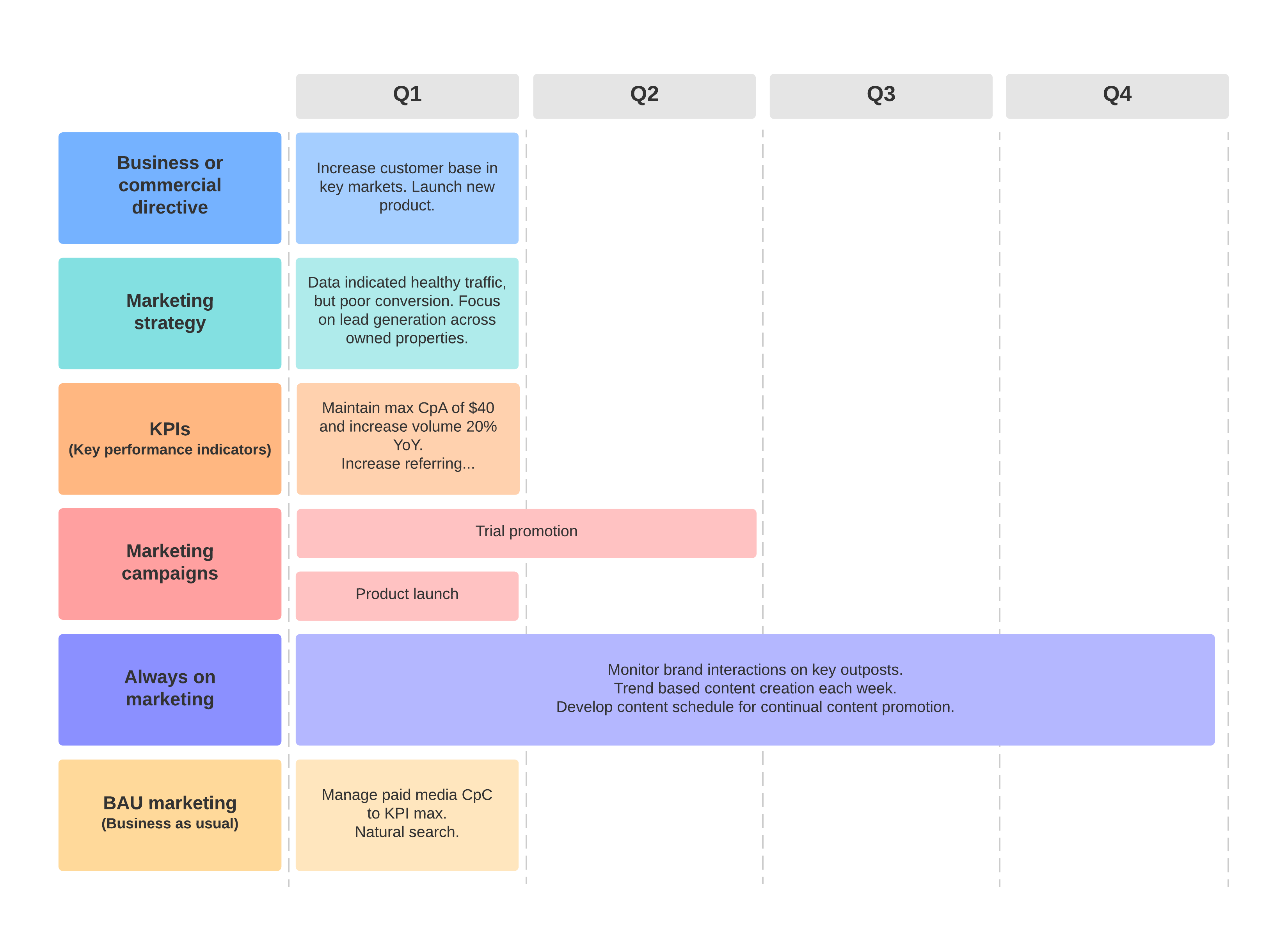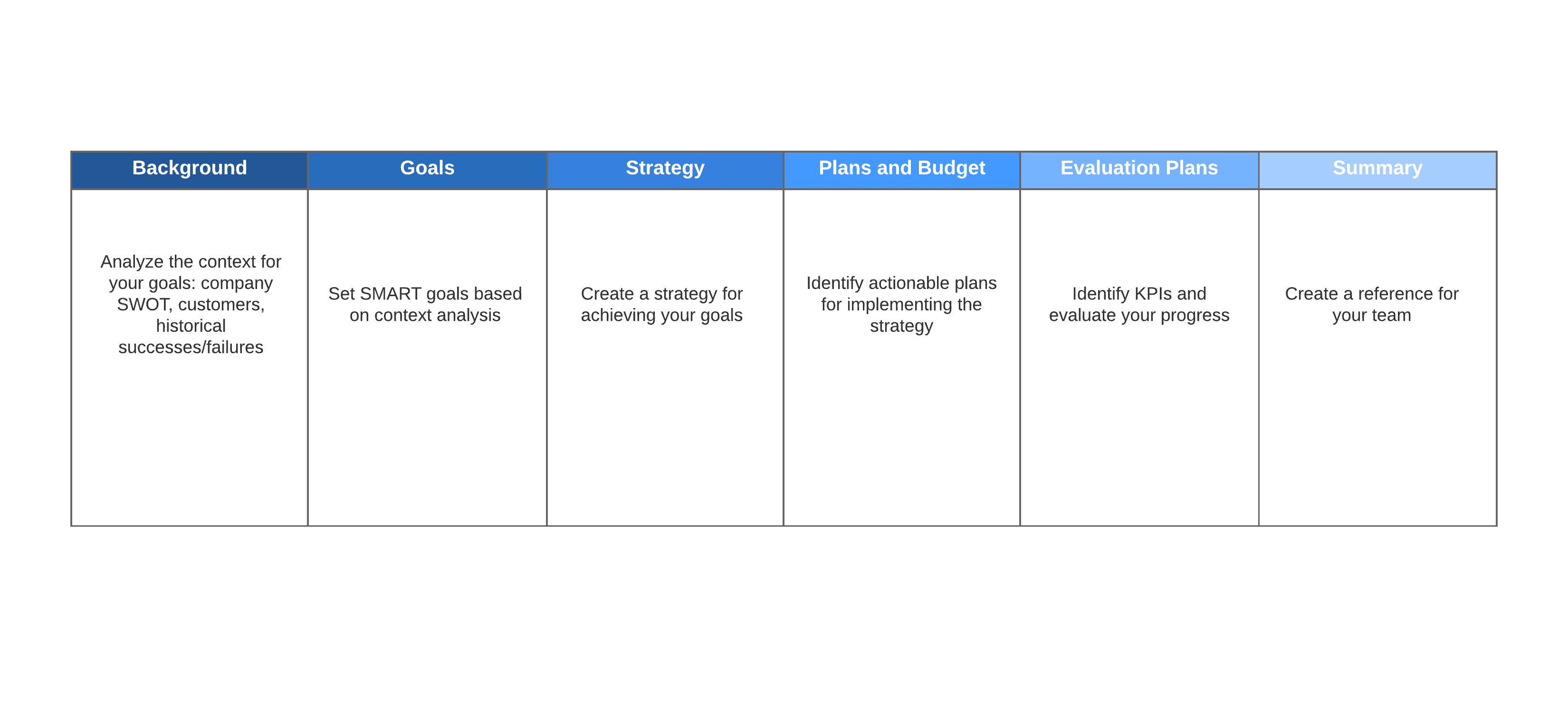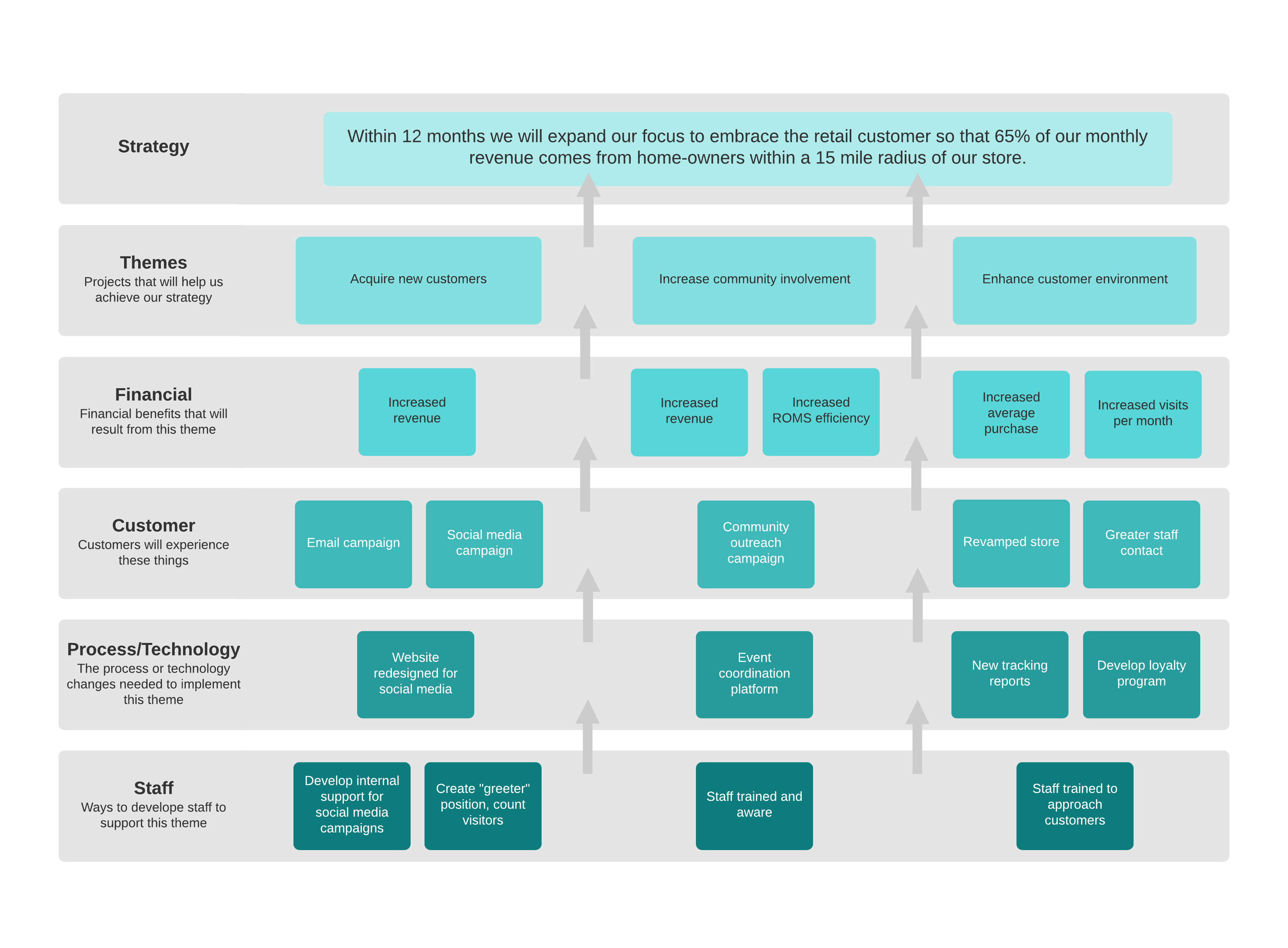
How to create a marketing plan template you’ll actually use
Reading time: about 6 min
Topics:
How to create a marketing plan
- Background: Who are your customers and what does their buying cycle looks like
- Goals: SMART goals that clearly outline your timeframe and metrics
- Strategy: Inventory your assets and decide how you will make use of them
- Budget: Make a list of action items and include a budget for each
- Evaluation: Monitor KPIs that will help you evaluate your progress
- Summary: List the main takeaways from your plan and use them as reference
Where do you see your business going next quarter? Next year?
And if you’re involved in your company’s marketing efforts, how will you make sure your company reaches these goals?
If you don’t already have clear, well-defined answers to these questions, then you need to create a marketing plan. A good marketing plan serves as a map for your organization, leading you toward success. Keep reading to learn what makes a good marketing plan, then use our marketing plan template to get started today.

Why you need a marketing plan template
Proper planning is essential to success. When you have a good plan, you know where you want to go, when you want to get there, and—perhaps most importantly—how you can reach that point. It can save you time, money, and frustration.
Think of it this way: You’d never see a builder constructing a house without planning the materials, timeline, and floorplan first. Builders plan extensively, using blueprints to guide their work. As a result, they can consistently meet their building goals.
While there are many useful diagrams that marketers can use in their planning, nothing beats a solid marketing plan. A marketing plan defines goals, strategies, and key performance indicators for your organization to guide your choices. The carefully crafted goals and strategies in your plan will help you create marketing campaign templates that get you where you want to go. Likewise, you can compare a proposed campaign to your marketing plan. If it does not support the goals outlined in your plan, you’ll know to shelve it.
Of course, a poorly constructed marketing plan won’t get you very far. For example, if your goals are vague or unreachable, it will be difficult to know if you’re making progress toward them. You need to construct a marketing plan that is specific enough to provide meaningful guidance—and you can get started with a solid marketing strategy template.
Building an effective marketing plan
In order to provide a sufficient roadmap for your organization, a good marketing plan contains several parts. Some parts may require more detail than others, but each part is necessary to create a clear, actionable plan.

Visualizing your marketing strategy with Lucidchart
An effective marketing plan needs to be readable, available, and tailored to your organization. Lucidchart makes it easy to personalize an attractive marketing plan that you can share with your team.
Remember, the best marketing plan is the one you actually use and refer to. A useful marketing plan shouldn’t be too long or complex. Avoid overwhelming your plan with unnecessary detail, and include just the most important points. You can always link additional documentation to your plan as needed.
Background and business objectives
The background section lays the groundwork for everything else. It contains vital information about your organization, such as who your customers are and what their buying cycle looks like. Likewise, this section includes any pertinent company history, such as prior successful marketing campaigns that you wish to build on or marketing flops that led to course adjustments.
The background section also includes relevant research. At a minimum, this should include an honest analysis of your company’s strengths, weaknesses, opportunities, and threats, known as a SWOT analysis. This analysis will help you create appropriate goals for your business. The background section can also include a competitive analysis for further insight.

You may also want to include your business’s mission statement or vision to align your goals closely with your organizations overall objectives. In addition, including any analyses you’ve conducted, such as your customer journey map, and buyer personas can be helpful in identifying areas of opportunity. You may have to simplify or summarize these analyses for brevity's sake, but you can always include greater detail in your additional documentation.
Goals
Draw upon your background to create two or three goals for your marketing plan. These goals should be SMART—that is, specific, measurable, achievable, results-focused, and time-bound. Clearly outline the timeframe and metrics in your goals. You can even include three to five smaller sub-goals that will help you achieve your main goals.
Your goals will obviously depend on your organization, but they may include reaching a sales quota, raising brand awareness, or achieving another measure of growth within a specific time period. Make these goals realistic but challenging. Remember, a marketing plan should help your organization succeed, and these goals define what success looks like.
Resist the temptation to list dozens of goals, and stick to two or three main objectives. These goals should stretch your organization, but they should be achievable.
Strategy
This section outlines how you plan to achieve the goals you just set. If, for example, your goal is to increase your online brand presence, you might create a strategy that focuses on distribution channels like Instagram marketing and email campaigns.
Conduct an inventory of your assets and decide how your strategy will make use of them. List things like your website, your social media pages, physical storefronts, etc. You should also strategize how your plan will use each role in your marketing team, such as SEO, copy, and design. You may wish to consult with members of these teams to get buy-in for their roles in your marketing plan strategy.

In addition to taking advantage of your company’s assets, your marketing strategy template should take into account your team's capabilities, including website updates, content creation, SEO implementation, various distribution channel campaigns, and other branding efforts.
Plans and budget
Your marketing strategy should get specific at this point, including actionable plans for implementing your strategy. These plans can include specific campaigns to create or actions to take. You might, for example, draft an Instagram campaign for the social media strategy you planned. Or you might plan to hire a new web designer to help with the website refresh you strategized.
While previous sections contain the theoretical framework for your plan, this section includes executable actions. Make a list of action items for all involved parties to attach in your additional documentation. Your plan needs to work within your constraints, including timeframe and budget. You can refine or even alter these plans later, but create them with the intent of using them as is.
Evaluation plan
Make sure you remain on track with your plan. That’s why this section contains key performance indicators (KPIs) that will help you evaluate your progress. These KPIs will, of course, depend on the nature of your goals and plans.
In addition to planning how you evaluate progress, you need to plan how often you will evaluate. Again, this will depend on your organization and your goals. Some KPIs are best measured quarterly, while others are best measured on a weekly basis. List out who will be responsible for conducting evaluation, and consider putting regular evaluation meetings on the calendar at this point.
Summary
Your summary should list the main takeaways from your plan. This section will become a reference point for your team, and it ensures that everyone understands the important parts of your plan. Rather than try to perfectly summarize every part of the plan, simply include the information your team will need the most to achieve your goals. Keep it brief to maximize its usefulness.
Start your marketing plan now
Don’t waste any more time on aimless marketing. Use Lucidchart to create a marketing plan that will help your team make and meet challenging goals. Plan for success with our marketing plan templates, and then watch as your team follows your plan to achieve great things.

Explore how our very own marketing teams use Lucid to propel their marketing efforts to the next level.
Check it outAbout Lucidchart
Lucidchart, a cloud-based intelligent diagramming application, is a core component of Lucid Software's Visual Collaboration Suite. This intuitive, cloud-based solution empowers teams to collaborate in real-time to build flowcharts, mockups, UML diagrams, customer journey maps, and more. Lucidchart propels teams forward to build the future faster. Lucid is proud to serve top businesses around the world, including customers such as Google, GE, and NBC Universal, and 99% of the Fortune 500. Lucid partners with industry leaders, including Google, Atlassian, and Microsoft. Since its founding, Lucid has received numerous awards for its products, business, and workplace culture. For more information, visit lucidchart.com.
Related articles
How to refine your marketing funnel and earn devoted customers
Marketing teams can use the marketing funnel to see how customers find their company and why they choose it. See how to make one in Lucidchart!
Diagram Your Way to Marketing Success
Marketing is evolving, and it can be tough to keep up. A diagram can take the most complex marketing system or process and create a lasting, effective, shared resource.
How to use storyboarding for marketing and business development
Storyboards are no longer confined to film. Teams organize ideas with storyboards in every industry. Learn how and why.
